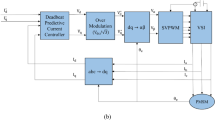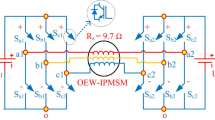Abstract
This study conducts load torque estimation in an induction motor (IM) with uncertainty using a dynamic sliding mode controller (DSMC) that suppresses chattering using an integrator or a low-pass filter placed before the control signal of the system. Hence, the dimension of the augmented system in DSMC is larger than the dimension of the original system, thus leading to an increase in the number of system states. These new state variables should be determined to control such a system. To address this problem, a new nonlinear state observer (NSO) is suggested and utilized in this study. The proposed method is independent of the uncertainty bound of the system, but the system output must be accessible. These subjects are important in practical implementations. Lyapunov theory is applied to validate the stability of the proposed DSMC and NSO methods. Then, the boundedness of the closed-loop signals is concluded from the stability of the proposed techniques. The validity of the proposed approach is evaluated using an IM model. By using DSMC and NSO, we can simultaneously control the IM and estimate its load torque. In particular, the external bounded load torque signal is compensated by the input control signal of the motor. Simulation results illustrate the advantages of the proposed approach.
Similar content being viewed by others
References
B. K. Bose, Power electronics and AC drives, Englewood Cliffs, NJ: Prentice-Hall (1986).
D. W. Novotny and T. A. Lipo, Vector control and dynamics of AC drives, New York: Oxford Univ. Press (1996).
A. Goedtel, I. N. da Silva and P. J. Amaral Semi, Load torque identification in induction motor using neural networks technique, Elsevier, Electric Power Systems Research, 77 (1) (2007) 35–45.
C.-M. Lin and C.-F. Hsu, Adaptive fuzzy sliding-mode control for induction servomotor system, IEEE Transaction on Energy Conversion, 19 (2) (2004) 362–368.
W.-J. Wang and J.-Y. Chen, A new sliding mode position controller with adaptive load torque estimator for an induction motor, IEEE Transactions on Energy Conversion, 14 (3) (1999) 413–418.
O. Barambones, P. Alkorta and J. M. Gonzalez de Durana, A real-time estimation and control scheme for induction motors based on sliding mode theory, Elsevier, Journal of the Franklin Institute, 351 (2014) 4251–4270.
A. Karami-Mollaee, N. Pariz and H. M. Shanechi, Position control of servomotors using neural dynamic sliding mode, Transactions of the ASME (American Society of Mechanical Engineering), Journal of Dynamic Systems, Measurement and Control, 133 (6) (2011) 141–150.
H. Lee and V.-I. Utkin, Chattering suppression methods in sliding mode control systems, Elsevier, Annual Reviews in Control, 31 (2) (2007) 179–188.
S. Lu, M. Lian, M. Liu, C. Cho and C. Piao, Adaptive fuzzy sliding mode control for electric power steering system, Springer, Journal of Mechanical Science and Technology, 31 (6) (2017) 2643–2650.
T. Sun, H. Pei, Y. Pan, H. Zhou and C. Zhang, Neural network-based sliding mode adaptive control for robot manipulators, Elsevier, Neurocomputing, 74 (14–15) (2011) 2377–2384.
M.-J. Zhang and Z.-Z. Chu, Adaptive sliding mode control based on local recurrent neural networks for underwater robot, Elsevier, Ocean Engineering, 45 (2012) 56–62.
Y. Zou and X. Lei, A compound control method based on the adaptive neural network and sliding mode control for inertial stable platform, Elsevier, Neurocomputing, 155 (2015) 286–294.
S. Mefoued, A second order sliding mode control and a neural network to drive a knee joint actuated orthosis, Elsevier, Neurocomputing, 155 (2015) 71–79.
Y. T. Oh and S. I. Han, Finite-time sliding mode joint positioning error constraint control for robot manipulator in the presence of unknown deadzone, Springer, Journal of Mechanical Science and Technology, 32 (2) (2018) 875–884.
H. M. Kim, S. H. Park and S. I. Han, Precise friction control for the nonlinear friction system using the friction state observer and sliding mode control with recurrent fuzzy neural networks, Elsevier, Mechatronics, 19 (2009) 805–815.
W. Perruquetti and J. P. Barbot, Sliding mode control in engineering, CRC Press (2002).
J.-J. E. Slotine and W. Li, Applied nonlinear control, Prentice-Hall (2002).
M.-S. Chen, Y.-R. Hwang and M. Tomizuka, A statedependent boundary layer design for sliding mode control, IEEE Transaction on Automatic Control, 47 (10) (2000) 1677–1681.
A. Levant, Sliding order and sliding accuracy in sliding mode control, International Journal of Control, 58 (1993) 1247–1263.
G. Bartolini, A. Ferrara and E. Usai, Chattering avoidance by second-order sliding mode control, IEEE Transaction on Automatic Control, 43 (2) (1998) 241–246.
A. Levant, Robust exact differentiation via sliding mode techniques, Elsevier, Automatica, 34 (1998) 379–384.
M. Chen, C. Chen and F. Yang, An LTR-observer-based dynamic sliding mode control for chattering reduction, Elsevier, Automatica, 43 (6) (2007) 1111–1116.
Author information
Authors and Affiliations
Corresponding author
Additional information
Recommended by Associate Editor Yang Shi
Ali Karami-Mollaee received his B.Sc. in electrical engineering from Ferdowsi University in 2002, M.Sc. in control engineering from Tarbiyat Modares University in 2005, and Ph.D. in control engineering from Ferdowsi University in 2010. His research interests include nonlinear control, adaptive control, and system identification. He is currently an Assistant Professor in Hakim Sabzevari University, Iran.
Hamed Tirandaz received his B.Sc. in applied mathematics from the University of Sabzevar Tarbiat Moallem University in 2006 and M.Sc. in mechatronics engineering from Semnan University, Iran, in 2009. He has been working as a Lecturer at Hakim Sabzevari University since 2010. His research interests mainly include chaos control and synchronization. He has published several papers in the abovementioned area.
Rights and permissions
About this article
Cite this article
Karami-Mollaee, A., Tirandaz, H. Estimation of load torque in induction motors via dynamic sliding mode control and new nonlinear state observer. J Mech Sci Technol 32, 2283–2288 (2018). https://doi.org/10.1007/s12206-018-0439-7
Received:
Revised:
Accepted:
Published:
Issue Date:
DOI: https://doi.org/10.1007/s12206-018-0439-7




